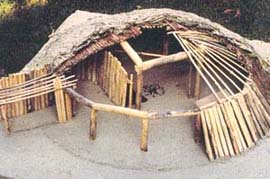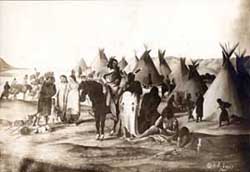|
TIMELINE |
|
| 11,500
B.C. |
| Clovis hunters kill
mammoths at end of Ice Age |
| 10,000 |
| Folsom hunters chase
giant bison |
| 7,000 |
| Plains Archaic hunters
move into region |
| 3,000 |
| Plains Archaic peoples
carve petroglyphs |
| 200 |
| Woodland peoples build
mounds |
| |
| A.D.
1000 |
| Middle Missouri people
begin farming |
| 1300 |
| Coalescent peoples enter
South Dakota and Little Ice Age begins |
| 1492 |
| Columbus sails to
America |
| 1700 |
| Arikaras, Cheyennes,
Crows, Lakotas, and other tribes live in South Dakota |
| 1743 |
| LaVerendryes visit South
Dakota |
| 1776 |
| Revolutionary War begins |
| 1785 |
| Pierre Dorion settles in
South Dakota |
| 1787 |
| U.S. Constitution
written |
| 1804 |
| Lewis and Clark
Expedition begins |
| 1913 |
| Students find La
Verendrye plate |
|
Lesson 2
A Changing World
Milder winters
and summers came to South Dakota. It was about one thousand years
ago. Villages sprang up along the rivers. One village was
near present-day Mitchell. Here, people built wattle and daub
houses. They wove twigs together and covered them with clay or mud.
These buildings had long walls dug into the earth. Men hunted bison,
but women began something new. They became the first farmers in
South Dakota.

Figures redrawn by Lynet Dagel from
Gilbert L. Wilson, Agriculture of the Hidatsa Indians, copyright 1983
by the South Dakota State Historical Society. Used with Permission.
The women
grew corn, beans, sunflowers, tobacco, squash, and pumpkins. They
made rakes, hoes, and knives from bones and antlers. They cooked in
large clay pots. They dug cache pits for storing food. These
farmers and hunters are now called the Middle Missouri people. They
were the ancestors of the Mandans.
Then the
climate changed again. It was about A.D. 1300. Archaeologists call
this time the "Little Ice Age." Winters grew long and
cold. Farming was harder. New tribes moved into South Dakota. They
came from the south and went up the Missouri River. They settled
near the Middle Missouri people.
|
|
Two hundred years passed. Many
native peoples now lived in South Dakota. Small towns dotted the
banks of the Missouri River. Here the Arikaras built
rounded houses. They dug them into the earth. They used tree
branches and clay for the roofs. The Arikaras traded corn,
vegetables, and tobacco for meat and buffalo hides. They traded
with the Mandans to the north. They also traded with the Crows, Cheyennes, and Pawnees, who lived west and south of the
Arikara villages. Soon the Arikaras were also trading horses.
Europeans brought horses back to America. These animals would
change the life style of the people of South Dakota.
|

Photo courtesy of State Archaeological Research Center, South
Dakota State Historical Society
|
|

Photo courtesy of South Dakota State
Historical Society
|
Our earliest written record of the Dakota, Lakota, and Nakota
(Sioux) peoples dates from the 1640s. French priests met them in
what is now Wisconsin. The people fished and hunted in deep
forests. They lived in houses made of bark and wood. Within a few
years, they began to move west toward South Dakota. Three groups
came to the Great Plains. Each had different customs and
languages. They all learned to ride horses and hunt buffalo. They
lived as nomads on the prairie. Soon, the Dakotas, Lakotas, and
Nakotas pushed the Arikaras north. They pushed the Mandans,
Cheyennes, and Crows farther north and west.
|